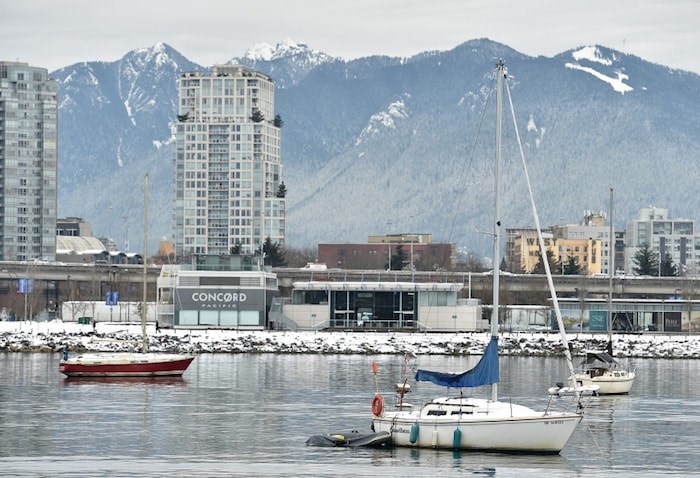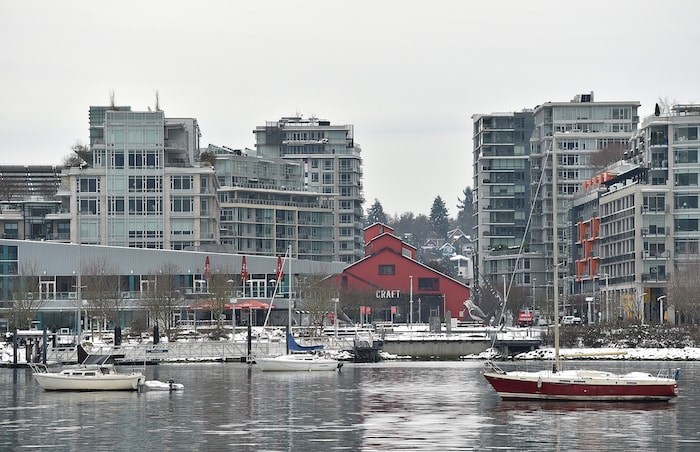A year ago this month, I wrote a story about the mayor of the day—Gregor Robertson—and some of his city councillors asking city staff whether the long-polluted inlet of False Creek would be swimmable by summer.
The short answer from park board biologist Nick Page was “no.”
 False Creek was once the city’s industrial heartland until it began to be redeveloped in the late 1960s. The remediation work to clean up the Creek and its shoreline continues. Photo Dan Toulgoet
False Creek was once the city’s industrial heartland until it began to be redeveloped in the late 1960s. The remediation work to clean up the Creek and its shoreline continues. Photo Dan Toulgoet
Fast forward to Wednesday and the question was raised again by some city councillors as they discussed a staff report related to False Creek and its water quality.
The answer again was not encouraging, as council heard from city manager Sadhu Johnston in response to a question from COPE Coun. Jean Swanson. The rookie councillor asked whether the previous council had a goal to make the Creek swimmable.
“We did have a goal from the previous council to make False Creek swimmable—that remains our goal,” said Johnston, noting the city continues to develop a “hydraulic model” of the Creek to better understand how water and pollution flows in and out of it.
Reaching that goal, as council heard from Margot Davis, the city’s manager of environmental services, continues to be hampered by the complex nature of the Creek. That complexity includes its history as the former industrial heartland of Vancouver (saw mills and ship building lined the shores) and its popularity with boaters, many of whom discharge sewage into the water.
 False Creek. Photo by Dan Toulgoet.
False Creek. Photo by Dan Toulgoet.
To the point, there are so many sources of pollutants that live or seep into the Creek—which is tidal and subject to temperature changes—that setting a date on when people can go for a swim is pretty much impossible.
While sewage from boats is a potential source of elevated levels of microbial contamination, others include combined sewer overflows operated by the city and Metro Vancouver, and storm water carrying land-based pollution.
Last year, the city also identified nine cases where sanitary systems were accidentally or illegally connected to storm water systems that flow into False Creek.
“Through conventional water quality testing, we know the amounts and the levels of the concentration [of microbial contamination], but we don’t actually know the source,” said Davis, who noted the city continues to work with Metro Vancouver, Vancouver Coastal Health and the B.C. Centre for Disease Control to improve water quality.
A city staff report elaborated on Davis’ comment, noting water quality testing is “limited as it solely provides information from a relatively small sample volume for a specific moment in time.”
The report added: “Given the complexity of the False Creek system, improving water quality necessitates a long-term approach involving multiple stakeholders and jurisdictions, and dependent upon systematic effort across a suite of key action areas.”
In other words, no swimming in the Creek this summer.
Also, that idea for a floating pool to be set up somewhere in the Creek, as envisioned in a report the previous council passed two years ago, is still simply an idea. Significant challenges and costs caused the city to give up on the pool for now, according to Johnston.
In the meantime, city council approved another year of a free mobile pump-out service for boaters to deter them from dumping sewage in the Creek. Both civic marinas have had pump-out services since 2015 but the mobile service was launched in 2017.
Over the course of two summers, the mobile service provided 730 “pump-outs,” collecting approximately 68,000 litres of sewage. The service costs the city $75,000 per year and is expected to increase to $90,000 from 2020 to 2024.
If there is some encouraging news from the city’s update on the Creek, the report notes water quality has “improved substantially over the past several decades.”
That can be attributed to many factors, including the city’s efforts to capture rainwater more naturally through the installation of bioswales near the Creek, which help trap sediments that cause pollution. The creation of Habitat Island near the Olympic Village has also helped improve water quality.
“Restoring natural shorelines supports ecological processes including temperature regulation, nutrient recycling, sediment trapping and water filtration, while also providing habitat and food for wildlife,” the staff report said. “Other possible initiatives include wrapping marina pilings with a non-toxic material to encourage herring spawning, and using bivalves such as mussels to filter the water.”
Calls for a swimmable False Creek are expected to get louder as the city proceeds with the development of Northeast False Creek. The plan envisions about 12,000 people moving into new homes over the next 20 years on 58 hectares of land that runs between the former Plaza of Nations site and into Chinatown.
Part of the plan calls for a swimmable beach along the False Creek shoreline.



